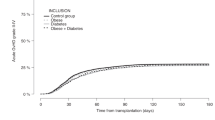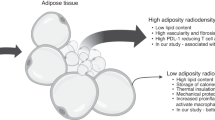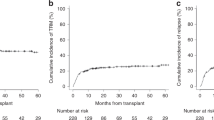Abstract
Background/Objectives:
The present work was performed to investigate the association between body mass index (BMI) before transplantation and the overall survival (OS) of patients with allogeneic hematopoietic stem cell transplantation (allo-HSCT).
Subjects/Methods:
Data from 310 adults who were diagnosed with acute leukemia and underwent allo-HSCT between March 2001 and December 2011 were analyzed. According to the suggested BMI categories for Asian population, patients with BMIs of ⩾23 and ⩾25 kg/m2 were identified as overweight and obese, respectively. Cox proportional hazards models was used to estimate hazard ratios (HRs) with 95% confidence intervals (CIs).
Results:
The median follow-up time among the patients was 19.7 months (interquartile range=8.1–37.7). A total of 93 (34.8%) people died within the follow-up period. After adjusting for the potential confounders, normal-weight, overweight and obese patients showed significantly lower HRs than those of underweight patients, with a significant trend of OS improvement upon increasing BMI (P=0.019). Overweight and obese patients survived longer, with a significantly decreased HR by ~40% (HR=0.60; 95% CI: 0.38–0.95) compared with underweight and normal-weight patients.
Conclusions:
An increased OS was seen in allo-HSCT patients with BMI⩾23 kg/m2 compared to those with lower BMI. Further work are still needed to investigate of the effects of BMI or body composition on the survival of allo-HSCT patients.
This is a preview of subscription content, access via your institution
Access options
Subscribe to this journal
Receive 12 print issues and online access
$259.00 per year
only $21.58 per issue
Buy this article
- Purchase on Springer Link
- Instant access to full article PDF
Prices may be subject to local taxes which are calculated during checkout



Similar content being viewed by others
References
Ng M, Fleming T, Robinson M, Thomson B, Graetz N, Margono C et al. Global, regional, and national prevalence of overweight and obesity in children and adults during 1980-2013: a systematic analysis for the Global Burden of Disease Study 2013. Lancet 2014; 384: 766–781.
Bhaskaran K, Douglas I, Forbes H, dos-Santos-Silva I, Leon DA, Smeeth L . Body-mass index and risk of 22 specific cancers: a population-based cohort study of 5.24 million UK adults. Lancet 2014; 384: 755–765.
Martin L, Birdsell L, Macdonald N, Reiman T, Clandinin MT, McCargar LJ et al. Cancer cachexia in the age of obesity: skeletal muscle depletion is a powerful prognostic factor, independent of body mass index. J Clin Oncol 2013; 31: 1539–1547.
Padwal R, McAlister FA, McMurray JJ, Cowie MR, Rich M, Pocock S et al. The obesity paradox in heart failure patients with preserved versus reduced ejection fraction: a meta-analysis of individual patient data. Int J Obes 2014; 38: 1110–1114.
Agarwal R, Bills JE, Light RP . Diagnosing obesity by body mass index in chronic kidney disease: an explanation for the ‘obesity paradox?’. Hypertension 2010; 56: 893–900.
Vashistha T, Mehrotra R, Park J, Streja E, Dukkipati R, Nissenson AR et al. Effect of age and dialysis vintage on obesity paradox in long-term hemodialysis patients. Am J Kidney Dis 2014; 63: 612–622.
Scherbakov N, Dirnagl U, Doehner W . Body weight after stroke: lessons from the obesity paradox. Stroke 2011; 42: 3646–3650.
Andersen KK, Olsen TS . The obesity paradox in stroke: lower mortality and lower risk of readmission for recurrent stroke in obese stroke patients. Int J Stroke 2015; 10: 99–104.
Carnethon MR, De Chavez PJ, Biggs ML, Lewis CE, Pankow JS, Bertoni AG et al. Association of weight status with mortality in adults with incident diabetes. JAMA 2012; 308: 581–590.
Gonzalez MC, Pastore CA, Orlandi SP, Heymsfield SB . Obesity paradox in cancer: new insights provided by body composition. Am J Clin Nutr 2014; 99: 999–1005.
Tsai S, Choti MA, Assumpcao L, Cameron JL, Gleisner AL, Herman JM et al. Impact of obesity on perioperative outcomes and survival following pancreaticoduodenectomy for pancreatic cancer: a large single-institution study. J Gastrointest Surg 2010; 14: 1143–1150.
Pfeiler G, Konigsberg R, Fesl C, Mlineritsch B, Stoeger H, Singer CF et al. Impact of body mass index on the efficacy of endocrine therapy in premenopausal patients with breast cancer: an analysis of the prospective ABCSG-12 trial. J Clin Oncol 2011; 29: 2653–2659.
Liang Y, Ketchum NS, Goodman PJ, Klein EA, Thompson IM Jr . Is there a role for body mass index in the assessment of prostate cancer risk on biopsy? J Urol 2014; 192: 1094–1099.
Jaime-Perez JC, Colunga-Pedraza PR, Gutierrez-Gurrola B, Brito-Ramirez AS, Gutierrez-Aguirre H, Cantu-Rodriguez OG et al. Obesity is associated with higher overall survival in patients undergoing an outpatient reduced-intensity conditioning hematopoietic stem cell transplant. Blood Cells Mol Dis 2013; 51: 61–65.
Deeg HJ, Seidel K, Bruemmer B, Pepe MS, Appelbaum FR . Impact of patient weight on non-relapse mortality after marrow transplantation. Bone Marrow Transplant 1995; 15: 461–468.
Navarro WH, Agovi MA, Logan BR, Ballen K, Bolwell BJ, Frangoul H et al. Obesity does not preclude safe and effective myeloablative hematopoietic cell transplantation (HCT) for acute myelogenous leukemia (AML) in adults. Biol Blood Marrow Transplant 2010; 16: 1442–1450.
Nikolousis E, Nagra S, Paneesha S, Delgado J, Holder K, Bratby L et al. Allogeneic transplant outcomes are not affected by body mass index (BMI) in patients with haematological malignancies. Ann Hematol 2010; 89: 1141–1145.
Finucane MM, Stevens GA, Cowan MJ, Danaei G, Lin JK, Paciorek CJ et al. National, regional, and global trends in body-mass index since 1980: systematic analysis of health examination surveys and epidemiological studies with 960 country-years and 9.1 million participants. Lancet 2011; 377: 557–567.
WHO Expert Consultation. Appropriate body-mass index for Asian populations and its implications for policy and intervention strategies. Lancet 2004; 363: 157–163.
Flegal KM, Kit BK, Orpana H, Graubard BI . Association of all-cause mortality with overweight and obesity using standard body mass index categories: a systematic review and meta-analysis. JAMA 2013; 309: 71–82.
Roberts S, Thompson J . Graft-vs-host disease: nutrition therapy in a challenging condition. Nutr Clin Pract 2005; 20: 440–450.
van der Meij BS, de Graaf P, Wierdsma NJ, Langius JA, Janssen JJ, van Leeuwen PA et al. Nutritional support in patients with GVHD of the digestive tract: state of the art. Bone Marrow Transplant 2013; 48: 474–482.
Browning B, Thormann K, Seshadri R, Duerst R, Kletzel M, Jacobsohn DA . Weight loss and reduced body mass index: a critical issue in children with multiorgan chronic graft-versus-host disease. Bone Marrow Transplant 2006; 37: 527–533.
Jain R, Chung SM, Jain L, Khurana M, Lau SW, Lee JE et al. Implications of obesity for drug therapy: limitations and challenges. Clin Pharmacol Ther 2011; 90: 77–89.
Muscaritoli M, Conversano L, Torelli GF, Arcese W, Capria S, Cangiano C et al. Clinical and metabolic effects of different parenteral nutrition regimens in patients undergoing allogeneic bone marrow transplantation. Transplantation 1998; 66: 610–616.
Michalek RD, Gerriets VA, Jacobs SR, Macintyre AN, MacIver NJ, Mason EF et al. Cutting edge: distinct glycolytic and lipid oxidative metabolic programs are essential for effector and regulatory CD4+ T cell subsets. J Immunol 2011; 186: 3299–3303.
Di Ianni M, Falzetti F, Carotti A, Terenzi A, Castellino F, Bonifacio E et al. Tregs prevent GVHD and promote immune reconstitution in HLA-haploidentical transplantation. Blood 2011; 117: 3921–3928.
Schneidawind D, Pierini A, Negrin RS . Regulatory T cells and natural killer T cells for modulation of GVHD following allogeneic hematopoietic cell transplantation. Blood 2013; 122: 3116–3121.
Yanez R, Lamana ML, Garcia-Castro J, Colmenero I, Ramirez M, Bueren JA . Adipose tissue-derived mesenchymal stem cells have in vivo immunosuppressive properties applicable for the control of the graft-versus-host disease. Stem Cells 2006; 24: 2582–2591.
Ahn JO, Chae JS, Coh YR, Jung WS, Lee HW, Shin IS et al. Human adipose tissue-derived mesenchymal stem cells inhibit T-cell lymphoma growth in vitro and in vivo. Anticancer Res 2014; 34: 4839–4847.
Acknowledgements
We thank members of Department of Hematology for excellent work.
Author information
Authors and Affiliations
Corresponding authors
Ethics declarations
Competing interests
The authors declare no conflict of interest.
Rights and permissions
About this article
Cite this article
Yang, J., Xue, SL., Zhang, X. et al. Effect of body mass index on overall survival of patients with allogeneic hematopoietic stem cell transplantation. Eur J Clin Nutr 71, 750–754 (2017). https://doi.org/10.1038/ejcn.2016.225
Received:
Revised:
Accepted:
Published:
Issue Date:
DOI: https://doi.org/10.1038/ejcn.2016.225
This article is cited by
-
Nutritional status and body mass index before hematopoietic stem cell transplantation (HSCT) and associated outcomes: a rapid review
Supportive Care in Cancer (2024)
-
Weight loss post-allogeneic stem cell transplant is associated with increased transplant-related mortality
Supportive Care in Cancer (2023)
-
Abnormal body composition related to the early clinical adverse outcome after HSCT
Bone Marrow Transplantation (2022)
-
Enteral nutrition protects children undergoing allogeneic hematopoietic stem cell transplantation from blood stream infections
Nutrition Journal (2020)
-
Nutrition Support Practices of Hematopoietic Stem Cell Transplantation Centers in Mainland China
Current Medical Science (2020)



